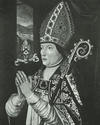 During the Middle Ages dress reflected the wearers' status, rank and profession such as the university scholars' black gowns. The church too displayed its wealth and power in its official vestments. Glasgow bishops were well travelled and cosmopolitan and their vestments would resemble those worn throughout Europe as can be seen from the portrait of Glasgow born William Elphinstone who became Bishop of Aberdeen (1488-1514). It shows him wearing an elaborate mitre (bishop's tall pointed cap) and cope (cloak) of dark red silk woven with gold and with additional gold embroidery. These may have come from Italy, but in Scotland there were skilled professional embroiderers capable of fine work, although virtually nothing remains as vestments and church embroidery were destroyed as a result of the Reformation.
During the Middle Ages dress reflected the wearers' status, rank and profession such as the university scholars' black gowns. The church too displayed its wealth and power in its official vestments. Glasgow bishops were well travelled and cosmopolitan and their vestments would resemble those worn throughout Europe as can be seen from the portrait of Glasgow born William Elphinstone who became Bishop of Aberdeen (1488-1514). It shows him wearing an elaborate mitre (bishop's tall pointed cap) and cope (cloak) of dark red silk woven with gold and with additional gold embroidery. These may have come from Italy, but in Scotland there were skilled professional embroiderers capable of fine work, although virtually nothing remains as vestments and church embroidery were destroyed as a result of the Reformation.
 There is little pictorial evidence of secular clothing worn before the 17th century particularly by working people, although doubtless their garments would have been simple and of poor quality, not unlike those depicted in illustrated manuscripts and books of hours. Often it is necessary to rely on descriptions in wills and household accounts. However there are a few rare paintings, such as the portraits of King James IV painted in 1507 and that of King James V and his wife Mary of Guise c.1538 in the richly bejewelled and fur trimmed silk and velvet garments worn at court. Carvings too are useful, including those on tombs and the roof bosses from Stirling Castle c.1540 that give a good idea of hats, hairstyles and upper garments with puffed sleeves and slashed doublets.
There is little pictorial evidence of secular clothing worn before the 17th century particularly by working people, although doubtless their garments would have been simple and of poor quality, not unlike those depicted in illustrated manuscripts and books of hours. Often it is necessary to rely on descriptions in wills and household accounts. However there are a few rare paintings, such as the portraits of King James IV painted in 1507 and that of King James V and his wife Mary of Guise c.1538 in the richly bejewelled and fur trimmed silk and velvet garments worn at court. Carvings too are useful, including those on tombs and the roof bosses from Stirling Castle c.1540 that give a good idea of hats, hairstyles and upper garments with puffed sleeves and slashed doublets.